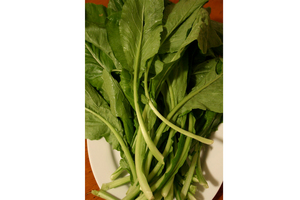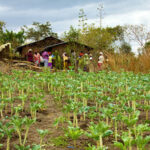Overview
The mustard plant is an excellent choice for a home garden. It is easy to grow, quick to mature, and it can be grown in a wide variety of climates.
Most gardeners will be interested in its green leaves for salads, but its seeds can also be used to make the popular condiment so beloved by Karl Childers of Sling Blade, the spicy spread that has given mustard the nickname “the King of Condiments.
Mustard is a member of the cruciferous vegetable family, and includes among its close relatives broccoli, brussels sprouts, cauliflower, collard greens, kale, and rutabaga. Among the most popular varieties of mustard greens are Florida Broadleaf, Green Wave, Southern Giant Curled, and Chinese greens including Choi Sum.
Planting
1. Some of the best times for planting mustard are in spring three weeks before the frost free date, again right about at the frost free date, starting again after midsummer when the temperatures fall off their peaks, and then into the fall. Mustard can certainly be grown throughout the summer, but it does least well in the hottest part of the season, so it’s recommended to use that time for other crops that thrive in the heat.
2. Plant mustard in loose and fertile soil. Mustard is a hearty crop that grows in most good garden soils. Plant where the developing plants will get full sun. The seeds should be planted one-third to one-half inch deep in the soil, between three and six inches apart, in rows divided by at least a foot. You can plant multiple seeds at each point, and thin as they sprout. The seeds will germinate in seven to ten days.
3. Keep your plants well fertilized to promote fast growing leaves. Regularly watering is important. If mustard plants gets insufficient moisture, they can go to seed early, just as can happen when they’re grown in the hottest weather.
Mustard greens can also conveniently be grown in containers. Plant one to two plants in a large pot with loose soil. Be especially diligent about keeping them well watered, as containers can dry out quickly. The plants are fairly compact and rarely grow more than three feet high.
Pests and Diseases
Rotate your crops to lessen the chances of soil diseases. That means not only avoiding planting where mustard has been growing in the past season, but also its aforementioned relatives in the cruciferous family such as broccoli and cauliflower.
One of the worst soil diseases is club root fungus, which causes the roots to swell up and the plants to wilt. Once it strikes, it is too late for this crop. Salvage what you can of the leaves that are not yet damaged, dig up the plants, use a different area of your garden for your next crop of mustard greens, and treat the affected area with a heavy dose of lime to eliminate the fungus.
Common downy mildew can make the mustard leaves misshapen, and cause a dusty covering or yellow splotches on the leaves. The chances of mildew will be lessened if your plants are properly spaced to promote air circulation, you keep them well fed with fertilizer so they grow fast, you avoid watering toward the evening, and you avoid getting the leaves themselves wet when you water. Mildew can be treated with a fungicide.
Key pests for mustard greens are cabbage worms and aphids. Cabbage worms are caterpillars of multiple species that eat holes in the leaves. They can be worse later in the growing season in the fall when their population has had several months to increase.
Examine the mustard leaves daily. Look closely, as cabbage worms are small and can blend in with the leaves.
Keep an eye open for colonies of tiny aphids on the undersides of the mustard leaves.
If you use insecticides, don’t spray shortly before you harvest the leaves.
Mustard does not compete well with weeds, so you’ll want to be diligent about keeping the area where you plant your mustard well weeded.
Harvesting
Most mustard plants mature in 45 to 50 days. Mustard leaves can be harvested throughout the growing season. Harvest the leaves while they are young and tender. The longer you wait and the larger the leaves get, the tougher they will be and the stronger the flavor will be. Three to four inches long is a good length.
You can either clip off the leaves with a scissors or knife and allow them to grow back to be harvested again, or you can cut the entire plant. Fall mustard leaves should continue to grow until you start getting regular frosts.
If a mustard plant goes to seed and puts up a flower stalk, it will not produce more leaves, so its harvest period is over.
If you are interested in harvesting the mustard seeds, wait for the plants to begin to yellow. You want to wait as long as possible for the seed pod to dry, but before it bursts and disperses its seeds.
Unless you plan to grow mustard again in the same area, avoid letting the seeds disperse in your garden as they will likely grow new plants the next season.
As it gets later in the fall, there probably won’t be enough hot weather to trigger seeding and flowering, so you likely won’t get seeds from late crops.
Mustard seeds can be used whole, or ground into prepared mustard condiment.
Storing
Mustard leaves stored in sealed plastic bags in the crisper drawer of your refrigerator should keep for at least three to five days. Wrapping them in moist paper towels may give you an extra day or two. The longer they are stored, the stronger their flavor tends to get.
If you wish to freeze mustard greens to keep them longer, wash the greens, trim the stem ends, place up to a pound at a time in boiling water and cover tightly for three minutes, remove them with a slotted spoon or blanching basket and transfer them to a large container of ice water, leave them in the ice water for five minutes, remove and drain, put them in sealed freezer containers with as much air as possible squeezed out, and place the containers in the freezer. Frozen mustard greens should be fine for up to a year.
Enjoying
The smaller, younger leaves are milder tasting and are ideal to use raw in salads. The larger, stronger tasting leaves can be cooked to make them milder. The taste of raw mustard greens has been compared to that of radish roots.
Green, leafy vegetables are an excellent source of nutrition. Mustard greens are low in calories and carbohydrates, and high in vitamins A and C, as well as K and E, and folic acid, iron and fiber. They are a good source of calcium for people who are lactose intolerant.
Mustard greens are high in the antioxidants and beta carotene that some scientists believe lessen the risks of cancer.
If you really want to enjoy mustard, be sure to celebrate National Mustard Day the first Saturday each August, perhaps with a visit to the National Mustard Museum in Mount Horeb, Wisconsin.
Sources:
“How to Grow Mustard.” The Gardener’s Network.
“How to Grow Mustard Greens.” Backyard Gardening Blog.
“Mustard.” University of Illinois Extension: Watch Your Garden Grow.
National Mustard Day.” Holiday Insights.




